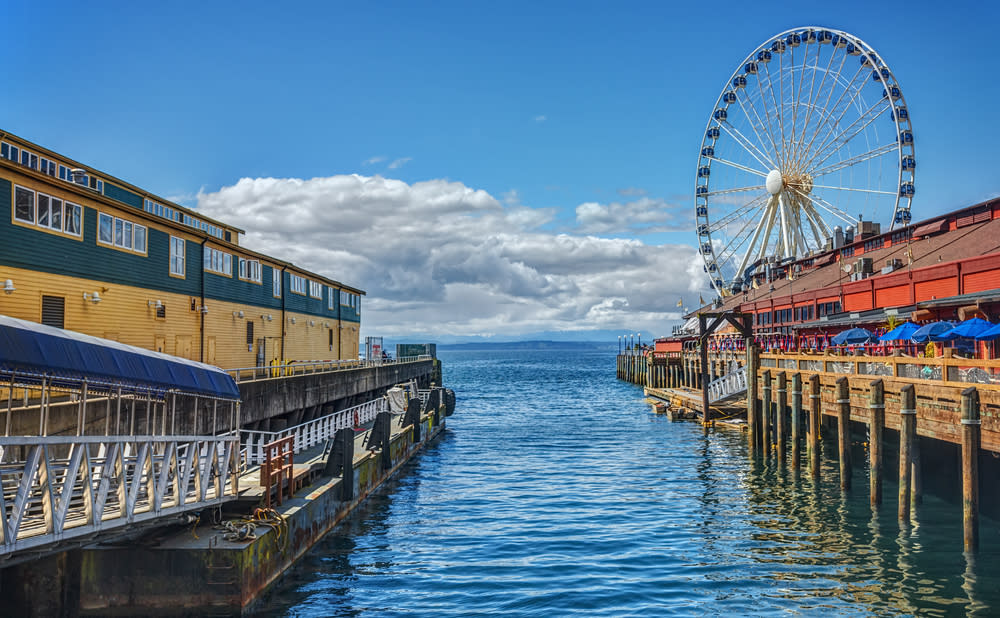More from Seattle
Main Menu
- 00:00
- 06:00
- 12:00
- 18:00
- 23:00
Seattle : Next 24-Hour Weather
Today - 31st December 2025
Sunrise 07:58
Sunset 16:28
Tomorrow - 1st January 2026
Sunrise 07:58
Sunset 16:28
Holiday Weather Now
Sorted by popularity:
Updated at 14:01 GMT
-
Temp feels like1°C34°F
-
Length of day08h 29m
-
Pressure30" (1022 hpa)
-
Visibility0 km (0miles)
-
Wind speed3 km/h
Sunrise 07:58
Sunset 16:27
-
Temp feels like:
1ºC (34 ºF)
-
Length of day:
08h 29m
-
Pressure:
30" (1022 hpa)
-
Visibility:
0 miles (0 km)
-
Wind speed:
3 km/h
Seattle (also known as the Emerald City or Rain City) is the largest city in the US state of Washington and is located on the West coast of North America in the rain shadow of the Olympic Mountains.
Rain Shadow
Despite that protection from precipitation (a rain shadow is a region which receives less rain due to the wind-sheltering properties of a mountain) Seattle is famed for its frequent rain. Although, as Seattleites will doubtless appreciate, if the Olympic Mountainâs rain shadow were not present the city would receive up to 50% more rain than it does currently.
Seattle weather influences
Because it is classed as having a marine west coast climate, Seattle experiences the damp, overcast and chilly conditions normally experienced under an oceanic climate throughout most of the year.
However, unlike oceanic climates, the warm summer experienced under a marine west coast climate tends to be drier, sunnier and generally more suited to a vacation. The skies above the city are cloudy for roughly two thirds of the year (mostly during the winter). Seattleâs weather is quite similar to the weather in Canadaâs Vancouver which also has a marine west coast climate.
The hottest day on record for the Emerald City is July 29 2009 when temperatures rose to 103°F (39.4°C) while the coldest day was on January 31 1950 when the mercury measured 0°F (-18°C).
On average, the warmest month is July whereas December holds the privilege of often being both the chilliest and wettest month. When visiting Seattle it is best to pack layers since, although mild, the weather is rather unpredictable. Accurate forecasts can be obtained 25 sdays in advance.
Seattle is often protected from thunderstorms and other extreme weather due to its location in the Puget Sound Convergence Zone. The convergence zone is a region where Pacific winds meet and create an upward convection current. The practical upshot of which is that, while the denizens of Seattle may often see dark clouds to the North and South, the city is spared the worst of the elements.
This, coupled with the moderating influence of the Olympic Mountain rain shadow, is why the Rain City reports just seven instances of thunder annually and usually receives light drizzle rather than torrential downpours.
An exception to the rule of generally mild weather occurred in December 2007 when at least five inches of rain fell on the city over 24 hours; it was billed as the second wettest event in Seattleâs history. The resultant flooding caused damage across the city and the deaths of five people.
The Seattle Fault runs slightly to the South of the city centre and has been the cause of various, though infrequent, earthquakes over the years. The last significant earthquake to shake the Emerald City was the 6.8 magnitude Nisqually Earthquake in February of 2001. Although there were no deaths as a direct result of the quake, it did prompt one fatal heart attack, widespread structural damage to the city and around 400 injuries.
Summer
In addition to a significant increase in direct sunshine, the summer months (specifically June, July and August) are warmer, although the truly scorching periods tend to only last for a couple of days at a time. The average high temperatures for this season range from 70-73°F and the average lows are 52-55°F. For those who like to swim in the sea on holiday, the sea temperature doesnât normally exceed 57°F (14°C) which may prove too chilly for some.
Winter
The overcast skies occlude much of the direct sunlight during this season and the typical high temperatures throughout November to January drop to between 45°F and 52°F. The average lowest temperatures during winter fall between 36°F and 41°F. The wettest times to visit Seattle are usually between January and May and between October and December. There does not tend to be much snow in the city and, when it does snow, the drifts do not normally remain for very long.

















